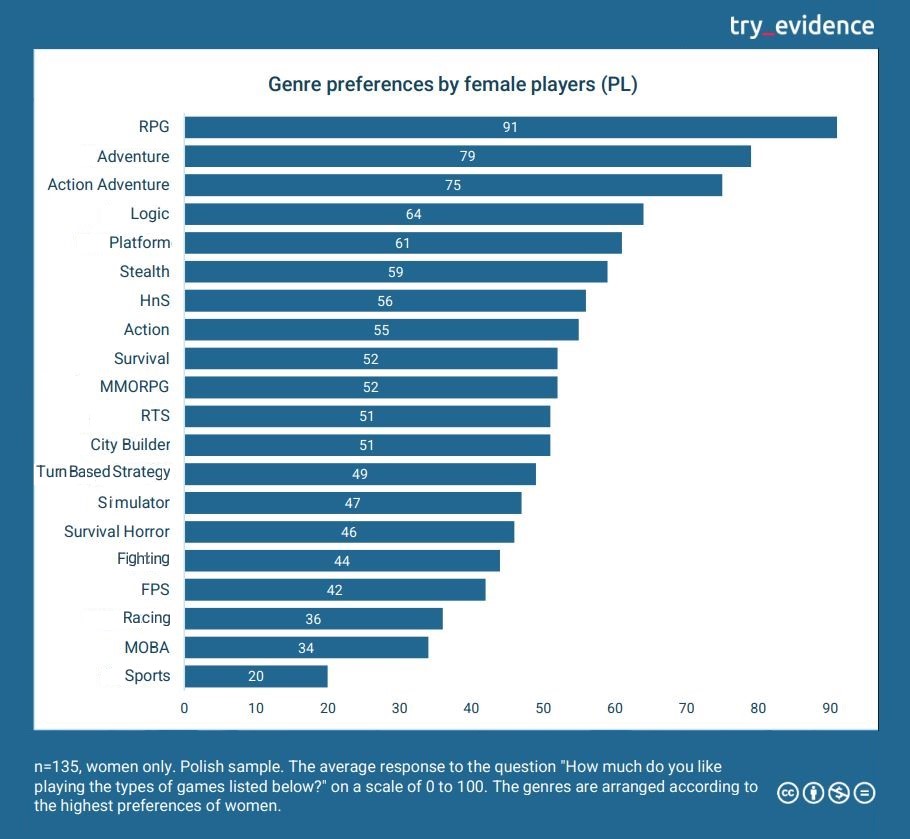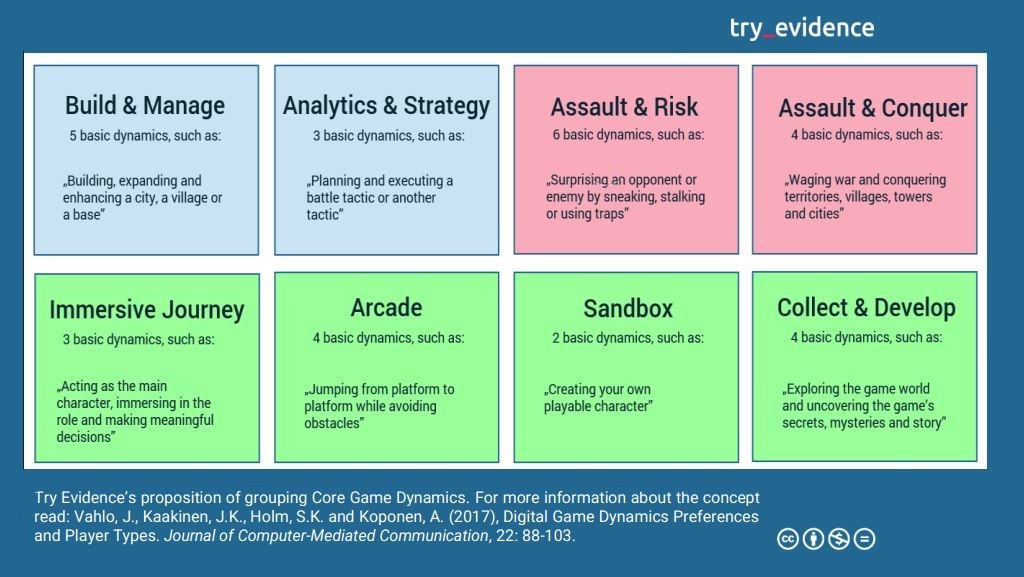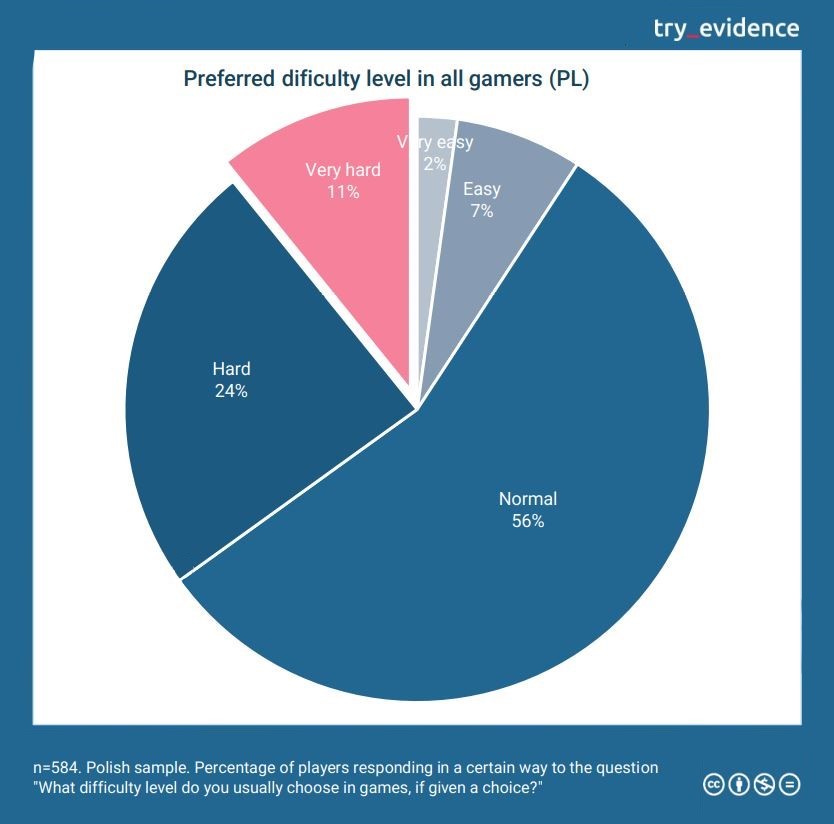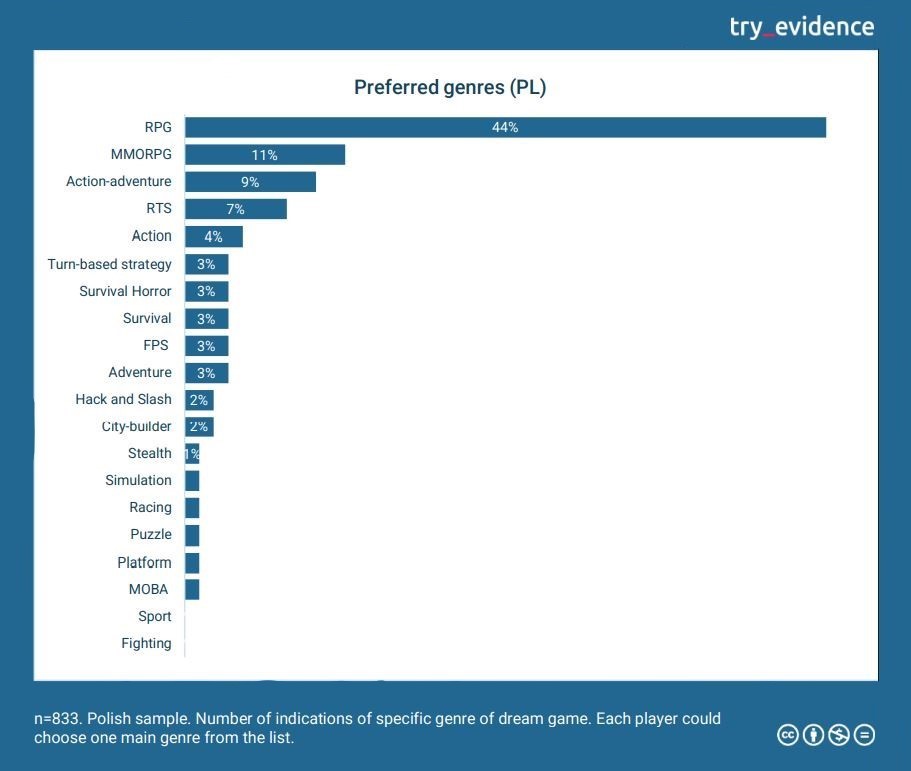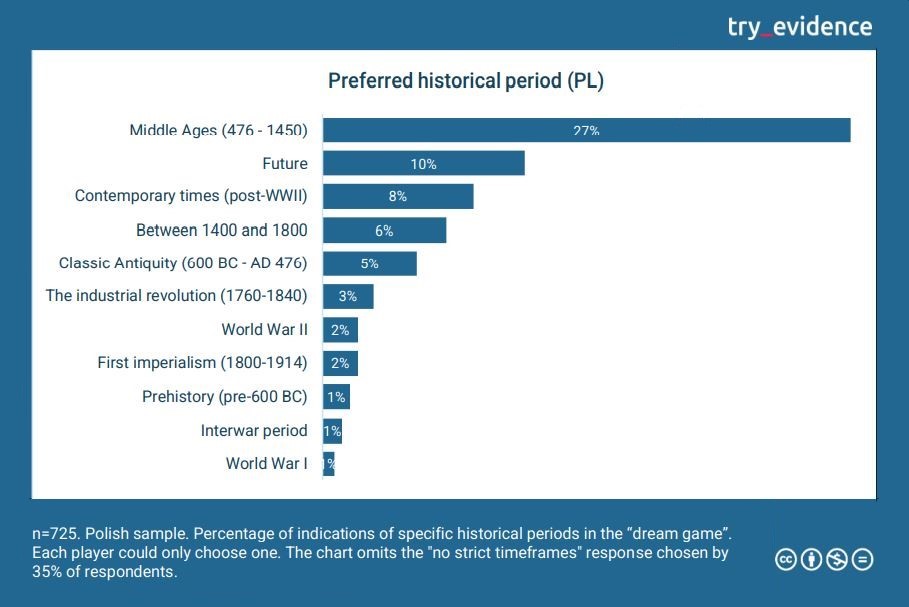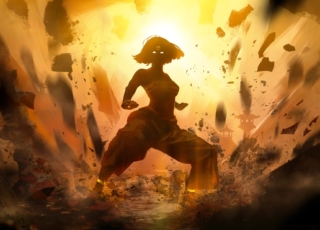REPORT: Women in Games−Insights on Female Gamer Trends
- February 7, 2022
- Try Evidence Research Team
Who are today’s female gamers? Do old stereotypes still hold, or have they evolved? Is it fair to assume that women’s gaming journeys start with building houses in The Sims and end with Candy Crush? And does a female protagonist make a game more appealing to women?
To answer these questions, we analyzed recent studies on women in gaming, along with our own extensive research on large samples of players. Based on this data, we present a comprehensive profile of the modern female gamer. This includes insights into how frequently women play, the duration of their gaming sessions, their preferred hardware, favored genres and settings, gameplay dynamics, chosen difficulty levels, and more.
How Many Female Gamers Are There?
In the collective consciousness, games are still associated primarily with men. Developers of large-budget console games have often designed their games with the assumption that the main audience closely resembles the developers themselves in terms of demographics. Even the Google Play Store showcases more male characters as app icons compared to female characters. Meanwhile, women are gaining importance as a relevant consumer group.
A 2020 report from Polish research firm IQS challenged stereotypes, revealing that women make up 47% of players in Poland. Given that around 17 million people in Poland play games, this means
an estimated 8 million Polish gamers are women—a statistic that might surprise many.
These findings align with global research from Newzoo, which also shows that women comprise 46% of all players worldwide. In the U.S. alone, where there are roughly 212.6 million players, this translates to nearly 100 million female gamers!
However, research shows that women far less likely self-identify themselves as gamers. Only 25% of women who played at least 30 minutes a week identified as gamers, while 55% of men did.

How and What Do Women Play?
Online reports indicating a high percentage of female gamers often trigger debate within the gaming community. In part because they sometimes combine data from casual mobile players and so-called “hardcore” gamers. In fact, 44% of women consider themselves casual gamers, while 23% identify as core gamers. This approach can blur the line between two distinct types of gaming engagement. It can create a misleading impression of the gaming community as a whole.
Dedicated gamers invest significant time and energy in their gaming experiences. Their engagement often leads to a deeper and more immersive experience compared to casual players, who typically dip in and out of games during their free moments.
Women Dominate Mobile Gaming Audience
One common stereotype suggests that women primarily play mobile games, and Google Play’s research supports this idea. In the U.S., an impressive 64% of mobile gamers are women, compared to just 38% who are men. This trend is particularly evident among women aged 10 to 65, with 65% actively engaging in mobile gaming. Moreover, female players aged 18 to 34 are the most likely to play mobile games compared to other age groups. Women also tend to play more frequently—43% play at least five times a week, while 38% of men do the same. Additionally, 76% of mobile gamers who enjoy puzzle games are women. In Poland, this trend continues; in 2019, women represented 68% of those who preferred casual mobile games.
These numbers clearly show that women aren’t just participating in mobile gaming; they’re leading the way in this growing market.
Almost half (44%) of female gamers play exclusively on mobile devices, compared to 27% of men. However, this doesn’t mean that women do not reach for equipment other than tablets and phones.
In our Video Gaming: Gender Differences and Stereotypes Survey* 52% of female gamers surveyed reported that they enjoy mobile games, although this doesn’t mean they don’t also play on PCs and consoles.
Genre Preferences—It’s Not Just The Sims for Women
The Sims series (Maxis) was labeled a “female” game. And indeed, according to IQS data from 2020, The Sims ranks as one of the top three most popular games among women. Surprisingly, two other most popular games among women are from stereotypically masculine franchises: the FIFA series (Electronic Arts) and Grand Theft Auto V (Rockstar Games).
Our international research Gaming Sense 2021: Stories and Archetypes**, conducted in July 2021, shows that Polish women actually differ from men in their preferences for some gaming genres.
The chart below reveals that men tend to favor genres like first-person shooters (FPS), strategies, real-time strategies (RTS), multiplayer online battle arenas (MOBA), hack-and-slashes (HnS), sports, action, and fighting games more than women. In contrast,
women show a stronger preference for adventure, puzzle, and platformer games.
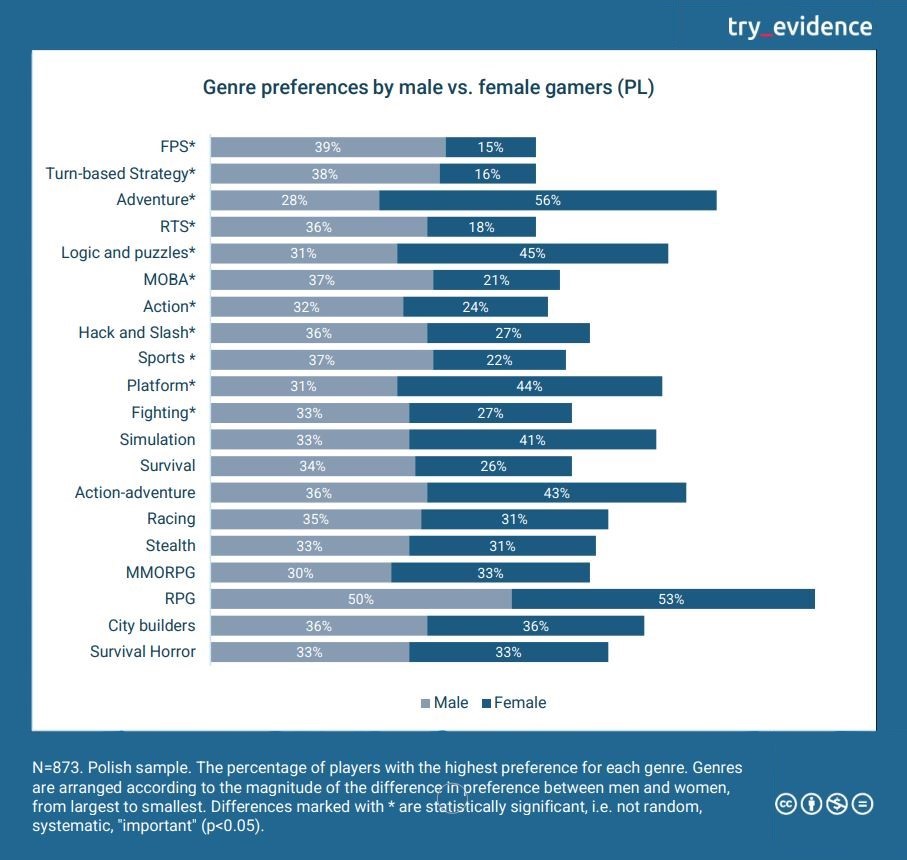
The chart below highlights genre preferences among female gamers, with RPGs emerging as the clear favorite. This strong preference for RPGs isn’t surprising; in all our surveys, RPGs consistently rank as the most popular genre among gamers worldwide, regardless of gender.
Following RPGs, adventure and action-adventure games ranked second among female players.
Interestingly, simulators—often stereotypically associated with women—ranked much lower, coming in fourteenth place.
On a preference scale of 0 to 100, simulators scored an average of 47. While they are somewhat more popular among women than men, this difference is minimal. While The Sims may be a standout, it appears that the simulator genre as a whole doesn’t hold the same level of appeal for female gamers.
In our study, Video Gaming: Gender Differences and Stereotypes,
67% of female participants identified story as the most important component of a game.
The next most valued aspect was interesting characters, though at a much lower rate—just 9%. Additionally, most women indicated a clear preference for single-player experiences, with 75% favoring single-player modes over multiplayer (25%).
They also leaned strongly towards third-person perspective (TPP), with 71% preferring TPP over first-person perspective (FPP) at 29%.
Game Dynamics Preferences
Game dynamics are the broader experiences that arise when a player engages with a game’s mechanics. Unlike mechanics, which are individual actions like “jump,” “run,” or “shoot,” dynamics are the outcomes of combining these actions.
Consider a game like Minecraft (Mojang Studios). Mechanics include actions such as “mining,” “building,” and “crafting.” On their own, these actions are simple, isolated tasks. However, when a player combines these mechanics—mining resources, crafting tools, and building structures—they create the dynamic of “surviving” or “exploring.” These dynamics emerge only as players use multiple mechanics together, turning individual actions into a cohesive experience of creating and navigating the world.
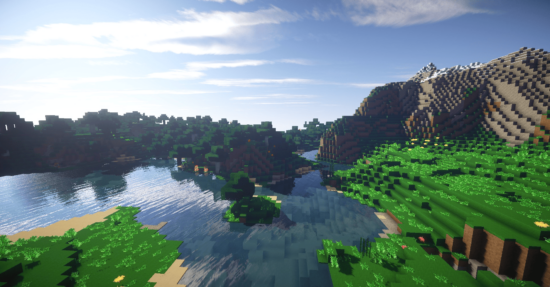
Classification of Game Dynamics
Our research and statistical analysis identified eight distinct groups of gaming dynamics, illustrated in the graphic below. This classification differs from the five categories proposed by researchers at the University of Turku: Assault, Manage, Journey, Care, and Coordinate. In general, these dynamics serve to categorize various player experiences and preferences, emphasizing how different gameplay elements appeal to diverse audiences.
Gender Differences in Game Dynamics Preference
Among Polish players, women showed significantly less interest in “Assault & Conquer” game dynamics typical of war and campaign games. Only 4% of women enjoyed these dynamics, compared to 35% of men. This observed difference can be attributed to a combination of psychological, social, and cultural factors.
Studies show that male gamers often gravitate towards games that involve competition and collaboration, whereas female gamers tend to prefer games that focus on exploration and thematic tasks. This distinction in motivation is further supported by findings that indicate women are less attracted to games characterized by violent content or competitive elements. This preference for less aggressive gameplay may stem from broader socialization patterns, where women are often encouraged to engage in cooperative rather than competitive behaviors.
The social context of gaming plays a crucial role in shaping preferences as well. Women are more likely to engage in gaming as a means of maintaining relationships, while men often view gaming as a competitive endeavor. This difference in social motivation can lead to a preference for genres that allow for social interaction, such as role-playing games, rather than traditional war or campaign games that emphasize conflict and competition. Another issue is that the gaming environment itself can be unwelcoming for women, with reports of harassment and a culture that often marginalizes female gamers, which may deter them from engaging in more competitive gaming genres.
Similarly,
women were less enthusiastic about dynamics in strategy and tactical games
—preferences that align with findings on genre choices. In contrast, women were more drawn to immersive dynamics that emphasize a “journey” within the game world, highlighting a preference for experiences that focus on exploration and narrative over conflict. Women in general are most fond of experiences, travel, immersion, and arcade areas of gaming.
The Appeal of Violent Dynamics
Surprisingly, violent and risky dynamics from the “Assault & Risk” category rank high among popular choices for female gamers, placing third despite the general trend of women preferring less aggressive gameplay. Many female gamers enjoy the thrill of high-stakes games, which may provide a sense of empowerment and excitement. Notably, gender isn’t the only factor at play—traits like extroversion, for instance, are linked to a greater enjoyment of violence in games.
The appeal of violent elements may stem from their exploratory nature as well, offering intense scenarios within controlled, fictional environments that feel less personal. However, female players are significantly divided on this preference. While nearly a third embrace these high-intensity dynamics, 41% report a clear preference for different styles, avoiding brutal or confrontational gameplay altogether. This polarization suggests that violent gaming dynamics have a substantial, yet varied, following among women.
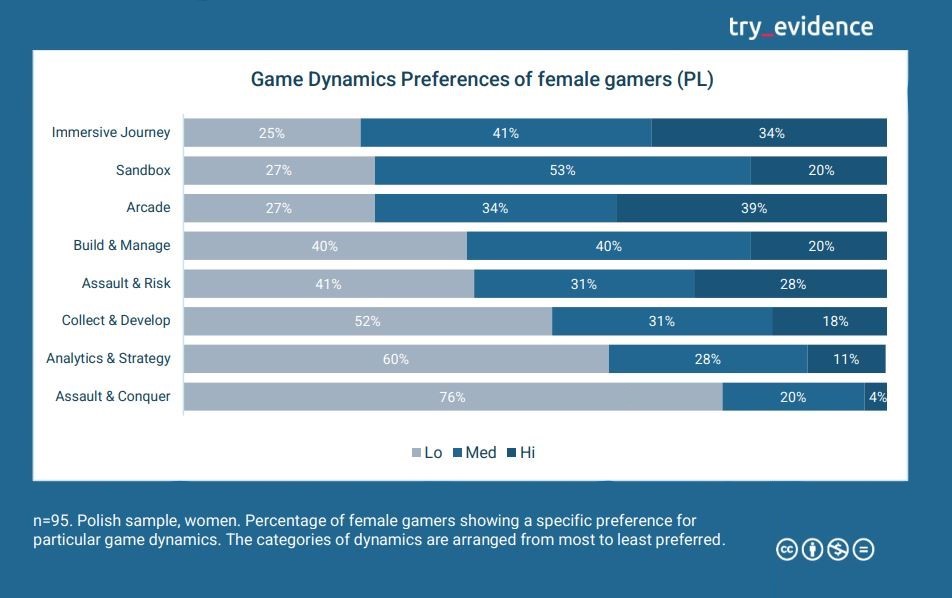
For male players, preferences for violent dynamics show a stark contrast. Men not only favor these intense, high-stakes dynamics but also express their enjoyment more strongly than women.
A striking 75% of male players report medium to high enjoyment of violent game elements, compared to only 24% of female players.
This difference highlights a gender-based divergence in how players engage with competitive and aggressive gameplay styles, with men demonstrating a much higher inclination toward these intense game experiences.
Understanding Game Dynamics Expectations
The above differences are very significant and probably the most differentiating between female and male players. It follows that
female gamers expect different experiences of game dynamics than men, perhaps even regardless of genre preferences and other factors.
Although both men and women enjoy RPGs the most out of all genres (this is according to our previous research), RPGs for women should be different in nature and based on different elements, than RPGs for men. This is, of course, a rather academic consideration, as developers don’t design games exclusively for women OR men. However, it can be a valuable indication for publishers, who can highlight other elements and assets of their games in the marketing communication of the title to particular segments of players.
Are Women Casual or Hardcore Gamers?
As stated earlier, there’s a common belief that female gamers mainly play mobile games, quizzes, and simulators—lighter titles that require minimal engagement. However, this assumption hasn’t been confirmed by any of our studies on large samples of Polish gamers, though mobile gaming was not specifically examined. According to Google Play’s Change the Game whitepaper, women’s top motivations for gaming include relaxation, stress relief, and entertainment.
Trendsetting
When considering “hardcore” gaming, one indicator is being a source of gaming information for others. In our Polish sample, about 9% of players frequently provide gaming advice to friends and acquaintances. Among women, such players-trendsetters were less than 8%, among men – slightly more than 9%. However, these were not statistically significant differences.
It could be said that male and female gamers were equally a source of gaming information for others.
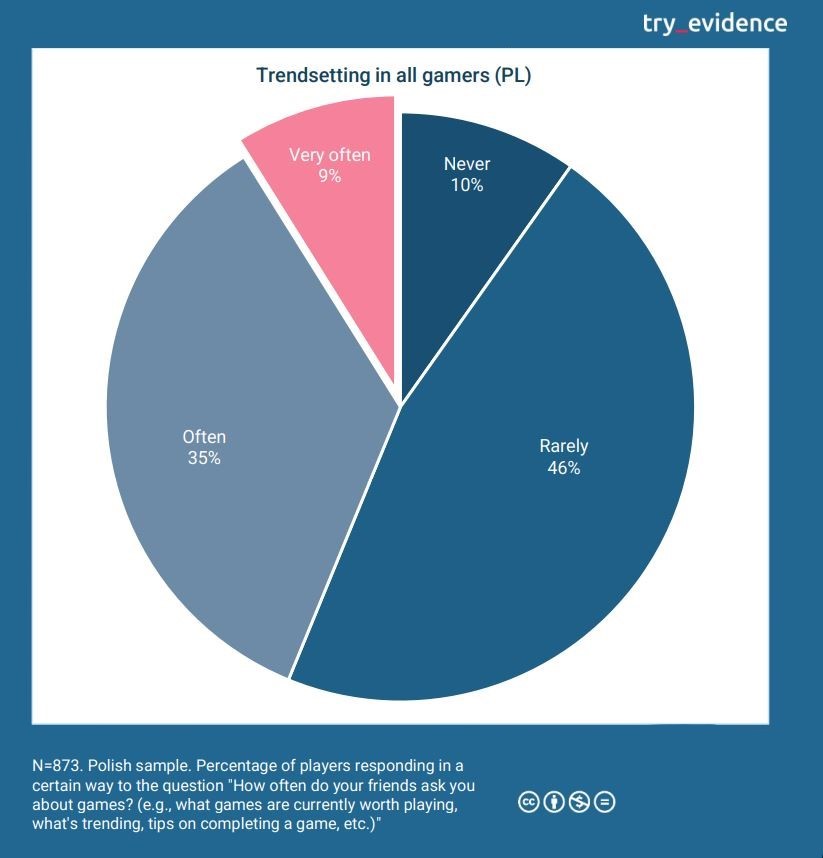
Completion Rates
Another question that diagnoses gaming style is: “How many games do you usually finish? (It’s about games that have a beginning and an end of some sort of storyline)”.
Polish female gamers exhibit similar completion rates to their male counterparts, with 79% of women and 78% of men reporting they finish most games (over 50% of games).
In our earlier study, Gaming Sense 2020, female gamers showed a slightly higher likelihood of completing over 75% of games compared to males. A similar trend, though slightly less pronounced, was observed in 2021, as visualised on the chart below. This data suggests that completion rates among genders in gaming are fairly aligned.
Free Time Allocation
Female gamers did not differ significantly from male gamers in one of the most important indicators of involvement in gaming, which is the declared proportion of their free time spent on playing video games.
Average gaming time is 53% of total free time in men and 49% in women.
However, a significant difference exists in the total hours played, as women typically have less free time overall. This disparity illustrates how the percentage of time spent gaming can vary dramatically in absolute hours, reflecting different lifestyle factors. We observed similarly strong differences between female and male players in their declarations regarding weekend hours. You can see weekday proportions in the chart below.
Preferred Difficulty Level
Perhaps the most telling indicator of “hardcoreness” in gaming is the preferred level of difficulty. Across both genders, approximately one-third of players lean toward hardcore gaming. However,
the proportion of female gamers who favor difficult and very difficult levels is significantly lower than that of male gamers.
This suggests that while some women may appreciate challenging gameplay, a larger proportion of male players tend to favor extreme difficulty levels. These games often demand exceptional skills and require significant time investment to master.
Female Core Gamer Landscape
So, how many women are considered hardcore gamers? Studies show that
about 23% of female players fall into the core category,
although research indicates that women are less likely to self-identify as gamers, based on personal perception and self-reporting.
Despite this, many female hardcore gamers actively participate in e-sports and participate in gaming on streaming platforms like Twitch and YouTube. Their contributions highlight the essential role women play in the gaming community, particularly within more competitive and intensive gaming environments.
Female Protagonists
Increasing Female Representation
Contemporary games increasingly pass the Bechdel Test, which is used as an indicator of women’s representation in culture. For a cultural text to meet this criterion, it must feature at least two named female characters who engage in conversation about topics other than men. Examples of games that achieve this include Night in the Woods (Infinite Fall), Life is Strange (Dontnod Entertainment), Portal (Valve Corporation), and Oxenfree (Night School Studio).
Female Protagonists Redefined
In modern games we can find plenty of female characters who successfully find themselves doing stereotypically male activities.
Examples include Lara Croft, the protagonist of the Tomb Raider series (Core Design), who is proficient with a variety of weapons and physically fit, Isabella Song from Song of Farca (Alawar), who is a computer scientist and hacker, or the sorceresses from The Witcher series (CD Project Red), who are involved in politics.
Feminist heroines in gaming extend beyond those who embody “stereotypically male” traits. Ellie from The Last of Us (Naughty Dog) exemplifies how female characters can express emotions like anger and a desire for revenge, traditionally viewed as male traits. This challenges the cultural notion that these feelings are unsuitable for women, asserting that women are equally entitled to express them. This broader representation of female characters enriches the narrative landscape of modern gaming.
Staying with the theme of emotional depth, Mae, the protagonist of Night in the Woods, struggles to express her feelings and aggression, making her an intriguing character. This adventure game, much like Life is Strange, taps into the theme of female friendship, highlighting the complexity of women’s relationships.
Contemporary titles also emphasize the significance of traditionally feminine traits. For example, Detroit: Become Human (Quantic Dream) explores motherhood, while Black Book (Morteshka) features a heroine learning to be a witch.
The Appeal of Customizable Female Protagonists
And what do female participants think about female protagonists Video Gaming: Gender Differences and Stereotypes?
Interestingly,
research shows that 79% of female gamers prefer playing as female characters,
indicating that such protagonists may enhance women’s interest in gaming. Moreover, a significant 81% of female players prefer to create their own playable character, compared to just 65% of male gamers. This preference for customization suggests a desire for more personal engagement in gaming experiences. Women are more likely to engage in games that foster social connections and relationships. Customization options enable unique character creation and interaction. Moreover, personalizing avatars allows female players to express their identities, offering an alternative to traditional gaming formats that often focus on hypermasculine or stereotypical representations.
Insights into Women’s Dream Games
When we talk about female protagonists, it’s important to think about the archetypes that truly connect with women. In our Gaming Sense 2021: Stories and Archetypes study, we asked gamers about their ideal games, focusing on various elements they would like to see. This included their:
- preferred genre,
- setting,
- type of story based on Christopher Booker’s narrative frameworks,
- historical context,
- cultural background or mythology,
- desired protagonist archetype, following the principles from The Hero and The Outlaw by Margaret Mark and Carol Pearson.
Dream Genre
An overwhelming, not to say crushing, majority of Polish gamers favor RPGs as their dream game genre. It’s challenging to determine the specific elements Polish gamers envision within the RPG genre, as our study did not explore those details. However, it’s evident that RPGs serve as a vast umbrella category, encompassing a wide variety of themes and gameplay styles that many gamers resonate with. This broad appeal is why RPGs stand out as the top choice for a dream game among respondents.
The differences between male and female preferences for game genres were striking. Notably,
none of the women surveyed expressed interest in designing their dream game as a real-time strategy (RTS),
indicating that, at least in Poland, it is viewed as a predominantly “masculine” genre. While 18% of women reported a strong liking for RTS in a separate question (see section “Genre Preferences–It’s Not Just The Sims for Women”), they still did not envision it as their ideal game. A similar pattern emerged for turn-based strategies, with no women choosing this genre for their dream game.
Conversely, a greater number of women than men expressed interest in genres such as action-adventure, MMORPGs, simulations, and survival horror. This preference highlights the diversity in female gamers’ interests. It showcases the aforementioned inclination toward genres that emphasize exploration and narrative, rather than competition or conflict.
Dream Setting
When it comes to dream settings, the “fantasy” genre emerged as the clear favorite among players. Other settings trailed far behind. Women showed slightly lower interest in post-apocalyptic and strictly historical settings compared to men. However, these variations in preferences were minimal. However, the overall choices in atmospheric styles were largely similar between genders. This highlights a shared by both genders enthusiasm for imaginative worlds, with fantasy reigniting players’ creativity and exploration desires.
Dream Story Type
Female players showed similar preferences to their male counterparts when it came to story types. Both groups showed a strong preference for the “Rebirth” theme, characterized by a protagonist’s significant transformation and focus on redemption. This was favored over the lighthearted tone of comedy, which typically involves humorous adventures and happy endings. This preference indicates a collective interest in deeper narratives that explore character growth and complexity. For a broader look at different story archetypes, you can refer to Christopher Booker’s The Seven Basic Plots: Why We Tell Stories.
Dream Historical Period
In terms of preferred historical periods, the Middle Ages emerged as the top choice among all players. Notably, 35% of respondents indicated that the specific historical context was unimportant to them. Female players, in particular, were more likely to express indifference, with 43% stating that historical setting did not matter. However, women chose the Middle Ages and the Renaissance to Enlightenment periods (1400–1800) less frequently than men. Although these differences were not statistically significant.
Dream Cultural Background or Mythology
We also inquired about players’ preferences for the cultural or mythological background in their dream games. Notably,
women showed a stronger inclination than men toward specific cultural settings.
About one in three Polish players expressed a preference for specific mythologies or cultural backgrounds in their games. The most favored options included Slavic, Viking (Nordic), Japanese, and Greek antiquity.
The difference between men and women in their preference for anchoring a story in a specific cultural or mythological background was notable. Women showed a greater interest than men in fairy-tale settings and elements related to Japanese culture.
Dream Protagonist
In terms of character archetypes, female players in Poland showed preferences similar to male players, gravitating toward “Outlaw,” “Hero,” and “Explorer.” These archetypes resonate widely across genders:
- Outlaw: A rebellious figure driven by intense emotions like anger or vengeance, challenging norms in pursuit of transformative change.
- Hero: A character seeking to prove their strength and resilience through courage, determinedly overcoming obstacles to achieve their goals.
- Explorer: A lover of adventure, fearlessly facing challenges to uncover personal truths and understand themselves.
These archetypes underscore a shared desire for dynamic, self-determined protagonists among gamers.
Women showed a particular interest in the “Mage” archetype, which contrasts with men’s stronger preference for the “Hero.” However, these variations weren’t statistically significant within the broader array of archetypes, which included Outlaw, Hero, and Explorer as the most popular overall. Based on previous research, the archetypes that likely resonate most with women are female variants of the Outlaw, Explorer, or Mage. However, female gamers tend to find the Hero archetype slightly less common. This suggests that character preferences for women lean toward roles marked by independence, curiosity, and intellectual power.
Interested to see extended results for gamers around the world? What they like, which games they play and what games they would create for themselves?
Contact usSummary
Women are carving a real space in the gaming world, not only as players but also as creators and influencers. It’s a common misconception that women predominantly play mobile or casual games. In reality, many female gamers actively enjoy RPGs, adventure, and action titles on PC and consoles. Their gaming tends to be more about immersion, story, and exploration than pure combat.
For many female players, a “dream game” focuses on RPG-style adventures set in medieval fantasy worlds. These games often feature stories centered on transformation, where characters experience rebirth or personal growth. Outlaw and anti-hero characters, who break conventions for a deeper cause, resonate strongly as preferred protagonist types. Women also gravitate towards games with rich mythological backdrops, especially Japanese or Slavic themes, adding layers to their game worlds.
With women’s representation growing, their influence is shaping game design and genre trends. Developers and publishers have a real opportunity to connect through these deeper narratives. Culturally rich storytelling choices are clearly important to women. Understanding what female gamers are drawn to—and why—could be game-changing.
Research Methodology
* Video Gaming: Gender Differences and Stereotypes Survey conducted between September and October 2020 on a sample of 2030 people belonging to gaming-themed social media groups (Gracze to My!, Golowicze, Raj dla graczy, Dragon Age – Polska, Mass Effect – PL), including 547 women (27%) and 1487 men (73%) Most respondents were aged between 18 and 24.
** Gaming Sense 2021: Stories and Archetypes: an international survey of players from key global markets (USA, JPN, KOR, GBR, FRA, RUS, DEU, ITA, CAN, ESP) and Poland. Total number of respondents in the global sample: N=2663, including 799 females and 1864 males over 13 years of age. In the Polish part, the data from which we present in this text, we collected 873 valid questionnaires, including 135 women and 738 men (not all players answered all survey questions).
_
Want to cite this article? Do it in an elegant way:
Try Evidence Research Team (2021, 15 10). REPORT: Women in Games–Insights on Female Gamer Dynamics
https://tryevidence.com/blog/report-women-in-games-insights-on-female-gamer-dynamics/


